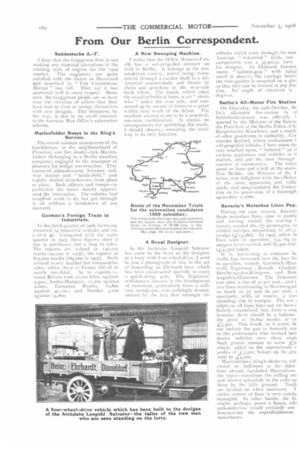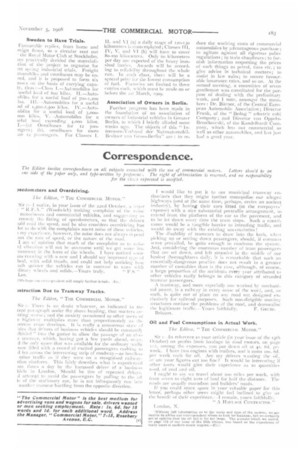From Our Berlin Correspondent.
Page 16

Page 17

If you've noticed an error in this article please click here to report it so we can fix it.
Suddeutsche A.-F.
I hear that the Ciaggenau firm is not making any material alterations in the existing type of engine for the 1909 market. The engineers are quite satisfied with the motor as illustrated and described in " TILE COMMERCIAL MOTOR " last fall. They say it has answered well in every respect. Moreover, the Gag,genau people are so busy over the excution of orders that they have had no time to occupy themselves with new designs. This briskness, by the way, is doe in no small measure to the German War Office's subvention scheme.
Marienfelder Buses in the King's Service.
The recent autumn manceuvres of the Gardekorps, in the neighbourhood of Prenzlau, saw five double-deck Marien!elders (belonging to a Berlin omnibus company) engaged in the transport of pioneers for bridge construction. They conveyed aides-de-camp between railway station and " battle-field," and rapidly shifted detachments from place to place. Both officers and troops—in particular the latter—keenly appreciated the innovation. The vehicles had roughish work to do, but got through it all without a breakdown of any moment.
German's Foreign Trade in Industrials.
In the third quarter of 1908, Germany imported 14 industrial vehicles and ex
wted 46. Compared xyith the same quarter in 1907, these figures show a rise in purchases, but a drop in sales. The imports are valued at t46,000 marks (91,000 in 1907); the exports at (o7,000 marks (685,000 in 1907). Switzerland nearly doubled her comparative sales, whilst those of France fell oil to nearly one-third. As to exports :— Great Britain took 12,100 kilos. against 9,5oo; Austro-Hungary, 11,200 against 9,000; European Russia, 11,80o against 41,100; and Sweden 3,000 against 14,800.
A New Sweeping Machine.
I notice that the I lilhn Motoren-Eabrik has a self-propelled sweeper on trial in Berlin. It belongs to the petrol-driven variety, power being transmitted through a cardan shaft to a differential countershaft, and thence by chain and sprot kels to the near-side back wheel. The brush, which takes the usual cylindrical form, is set " slantwise " under the rear axle, and connected up by means of levers to a point within easy reach of the driver. The machine seemed to me to be a practical, one-man combination. It carries no arrangements for sprinkling the roads, I should observe; sweeping the roadway is its only function.
A Royal Designer.
As the Archduke Leopold Salvator has come to the front as the designer of a lorry with four-wheel-drive, I send to you a photograph of him in the act of inspecting an Ehrhardt lorry which has been constructed specially to carry a quick-tiring gun. His I lighness' well-km n inlet est in the development of motorism, particularly from a military standpoint, was strikingly demonstrated by die fact that amongst the vehicles which went through the rece Austrian " industrial " trials out competition was a 35-4o4.p. lorry his designs. An Ehrhardt five-cell metre " balloon-gun " with tubul recoil is shown ; the carriage bearir the tube-guides is mounted on a pive so that they can be trained in any dire tion. Its angle of elevation is • degrees.
Berlin's All-Motor Fire Station
On Thursday, the 29th October, Bc lin's all-motor fire-station in tl Schonlankestras.se was officially i spected by the Minister of the Interic the President of the Berlin Police, Chi Burgomaster Kirschner, and a numb of other gentlemen in authority. Cor mander Reichel, whose enthusiasm I. self-propelled vehicles I have more th once touched upon, " lectured " on tl various appliances and vehicles at cl station, and put the men through number of manceuvres. The visit° spent an hour and a half at the statio Von Moltke, the Minister of the I tenor, was delighted with the efficien, of the men, apparatus, and rollir stock, and congratulated the Corpor Lion on its possession of a thorough up-to-date station.
Bavaria's Motorbus Lines Pay.
During, the past season, Bavaria State motorbus lines, nine in numbs and serving mainly the touring i (crests, carried 28,, t77 passengers, m yielded receipts amounting to 261,7 marks (1:13,086). In 1907, when in lines were in operation, 134,184 P1' sengers were carried, and 87,400 mar: (,4:4,370) taken.
It is interesting to compare he traffic has increased over the four lin in question, namely, Carmisch-Mitte wald, Tegernsee Kreuth Glashiitt Berchtesgaden-Kiinigsee, and Berc tesgaden-Hintersee. The first-nam can show a rise of 32 per cent., and t two lines terminating at Berchtesgad as much as 77 and 6o per cent. spectivelv, with, of course, a con sponding rise in receipts. The net ceipts on all lines have not yet been finitely ascertained, but, from a rout forecast, there should be a balance the good of 70,692 marks, or ov
-,3,500. This result, he it noted, dc not include the gra -;ts formerly ma to the postmasters who worked hon drawn vehicles over these mutt Such grants amount to some L77( which, added to the approximate r profits of 4:3,50n, brings up the gra total to -/74,200.
Marienfelders (single-deckers), eith closed or half-open at the sideshave already furnished illustrations the types--constitute the rolling sto and answer splendidly to the calls up them by the hilly ground. Trails are hitched on when necessary. T entire system of lines is very carefu managed. In other hands, the hr might, perhaps, prove a fiasco, ‘yhi anti-motorists would certainly use demonstrate the unprofitableness motorbuses. Sweden to Have Trials.
Favourable replies, from home and ,reign firms, to a circular sent out the Renal Motor Club at Stockholm, .tye practically decided the materialittion of the project to organise for xt speing industrial trials. Freight itomobiles and omnibuses may be eared, and it is proposed to form six asses on the basis of carrying capatv, thus :—Class L—Autarnobiles for useful load of boo kilos. TI.—Autosibiles for a useful load of 700-1,200 los. Ill. —Automobiles for a useful ad of 1,500-2,500 kilos. TV.—Autotobiles for a useful load of 3000000 kilos. V. -Automobiles for a seful load exceeding4,000 kilos. 1,—(a) Otnnihuses for 12 pas!tigers; (b), omnibuses for more an 12 passengers. For Classes I, II, and 1 I (a) a daily stage of iso-13o kilometres is contemplated ; Classes T11, IV, V, and VI (b) will have to cover So-too kilometres. Only Go kilometres per day are expected of the heavy ironshod lorries. Awards will be according to reliability throughout the whole run. In ench class, there will be a special prieo for the lowest consumption of fuel. Factories are limited to three entries each. Nvii:ch must be made on or before the 1st .larch, 1909.
Association of Owners in Berlin.
Furl her progress has been made in the foundation of an association of owners of iodustrial vehicles in Greater Berlin, to which I briefly alluded some weeks ago. The objects of this " lnteressen-Verband der NutzaulomobilBesitzer von Gross-Berlin" are : to re duce the working costs of commercial automobiles by advantageous purchase; to agitate against all rigorous police regulations; to train chauffeurs; to furnish information respecting the prices of such things as petrol, tires etc_ ; to give advice in technical matters; to assist in law suits; to secure favourable insurance rates, and so on. At the second meeting, a committee of seven gentleman was constituted for the purpose of dealing with the preliminary work, and I note, amongst the members : Dr. Burner, of the Central European Automobile Association; Director Frank, of the " Bedag " telectric cab) Company ; and Director von OppelnBronikowski, of the Kandelhardt C0111pally, which lets out commercial as well as other automobiles, and has just had a good year.




















